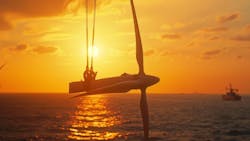Highlights include:
- Developer perspectives from Atlantic Shores Offshore Winds and Ørsted
- US regional report: DNV urges states to reorient solicitations
- Italy regional report: BayWa r.e.’s growing floating wind portfolio
- Vessels: newbuilds and enhancements
- Installation & maintenance
- Operations and maintenance costs
- Deepwater opportunities and engineering technology
- Challenges and opportunities for floating wind
- Commentary: Public perception of the offshore wind industry
Vineyard Wind and GE Vernova have initiated controlled cutting on turbine AW-38 at the Vineyard 1 wind farm development, 35 miles offshore mainland Massachusetts.
The aim is to reduce the damaged section that presents a risk of further debris falling into the ocean.
In addition, the US Bureau of Safety and Environmental Enforcement (BSEE) has issued an updated suspension order that allows Vineyard Wind to resume limited activities, including installation of towers and nacelles.
These components are not associated with the blade incident that occurred on July 13. However, the updated order does not permit further blade installation or power production for the time being.
Cutting operations, which took place Aug. 11-12, have removed much of the remaining portions of the damaged blade. Vineyard Wind and GE Vernova mobilized maritime crews on numerous vessels nearby to secure as much of the debris as possible for containment, with land-based teams managing debris recovery.
The two companies are now assessing further actions required to complete any additional cutting, secure and remove the debris on the turbine base, remove the blade root, and address debris on the seabed.
In advance of the updated order, BSEE examined an independent structural load analysis by DNV, a certified verification agent.
On Aug. 13, the Foss Prevailing Wind barge was due to sail from the New Bedford Marine Commerce Terminal carrying turbine components, including tower sections and one nacelle, for transportation to the Vineyard Wind offshore site.
It was also carrying a rack of three blades to ensure safe and balanced composition for the transport. The blades will not be installed offshore at this time, but they will be returned by the barge to the New Bedford terminal later this week.
The US Coast Guard maintains a 500-m safety exclusion zone around the AW-38 turbine. Vineyard Wind and GE Vernova will continue deploying vessels and aerial surveys, supported by US Coast Guard modeling to assess potential debris movement.
Vineyard Wind LLC is an offshore wind development company 50% owned by funds of Copenhagen Infrastructure Partners (CIP) and 50% owned by Avangrid Renewables LLC.
